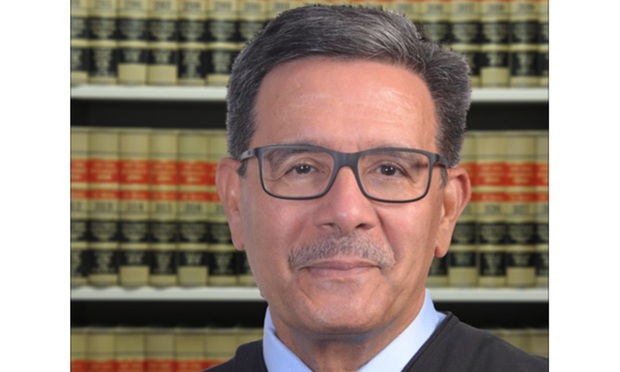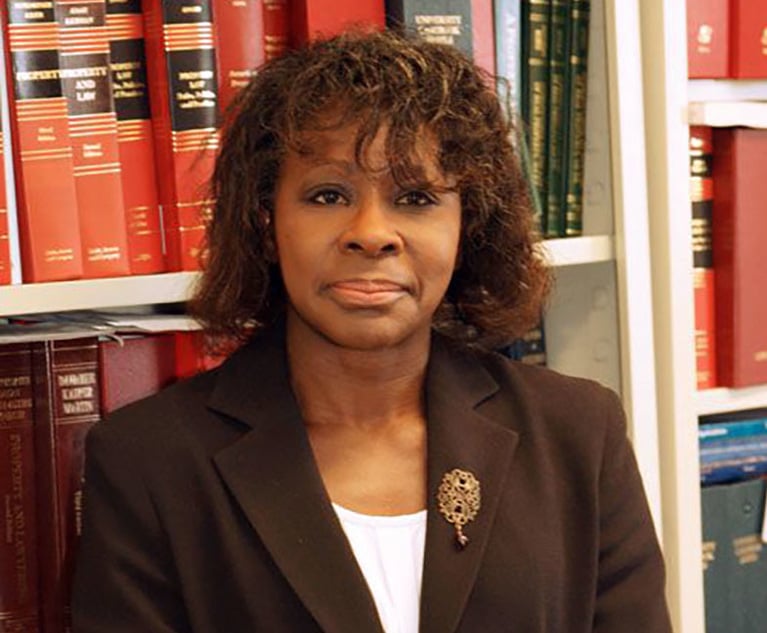Time To Finally Enshrine Women's Rights in the Constitution
Rolando T. Acosta, Presiding Justice of the Appellate Division, First Department, discusses the Equal Rights Amendment, which has yet to be incorporated into the U.S. Constitution. New York was one of the first states to ratify the proposed federal ERA in 1972, but has yet to pass a state ERA. He writes: Given the uncertain future of the ERA as an amendment to the U.S. Constitution, women's rights need to be protected under the New York Constitution.
April 30, 2020 at 02:05 PM
7 minute read
 Rolando T. Acosta
Rolando T. Acosta
"It was we, the people; not we, the white male citizens; nor yet we, the male citizens; but we, the whole people, who formed the Union. And we formed it, not to give the blessings of liberty, but to secure them; not to the half of ourselves and the half of our posterity, but to the whole people—women as well as men."
—Susan B. Anthony (1873)
Today, 100 years after the 19th Amendment established the right of women to vote, our state and federal constitutions still contain no provisions expressly guaranteeing over half of American citizens the same rights as men. In this centennial year of the 19th Amendment, it is appropriate to look back at some of the historical milestones in the struggle for women's suffrage and more generally, for women's rights, looking forward to a day, hopefully, in the not too distant future, when equality for women under the law is, at long last, enshrined in our foundational documents.
New York has long prided itself as the birthplace of the women's rights movement. In 1848, Jane Hunt, Lucretia Mott, Martha Wright, Mary Ann McClintock and Elizabeth Cady Stanton organized the historic Seneca Falls Convention in order to promote the battle for equality. Women's Suffrage in New York State, NYAssembly.gov. The Declaration of Sentiments and Resolutions read at the convention became the manifesto for the movement. Modeled after the Declaration of Independence, the Declaration of Sentiments declared that "[t]he history of mankind is a history of repeated injuries and usurpations on the part of man toward woman, having in direct object the establishment of an absolute tyranny over her" and insisted that women "have immediate admission to all the rights and privileges which belong to them as citizens of these United States," including the right to vote. National Park Service, Declaration of Sentiments.
Despite these efforts, the right of women to vote in New York and other states was not recognized for decades to come. In 1873, Susan B. Anthony was famously tried and convicted in upstate New York for illegally voting in the prior year's presidential election (she voted for incumbent Ulysses S. Grant). American Heritage, Susan B. Anthony Cast her Ballot for Ulysses S. Grant (December 1985). She and her counsel, former Court of Appeals Judge Henry R. Selden, had argued unsuccessfully that the 14th Amendment, which safeguards "the privileges" and "immunities" of United States citizens and guarantees them "equal protection of the laws," protected her right to vote (supra). Judge Selden urged the court that "no injustice can be greater than to deny to any class of citizens not guilty of crime, a share in the political power of a state, that is, all share in the choice of rulers, and in the making and administration of the laws." Presiding Judge Ward Hunt was unpersuaded and directed the jury to issue a guilty verdict against Anthony. Francis Murray, Henry Rogers Selden.
In 1917, New York state amended its Constitution to grant women the right to vote (NY CLS Const. Art. II, §1). It was one of the first states to do so. Three years later, ratification of the 19th Amendment added the following provision to the U.S. Constitution: "The right of citizens of the United States to vote shall not be denied or abridged by the United States or by any State on account of sex." This passage contains the only reference to women (albeit indirectly by using the word "sex") in the U.S. Constitution.
With the voting barrier finally broken in 1920, one might have expected that acknowledgement of equal rights for women would not be far behind. Any such expectation was sadly misplaced. Just as the passage of the 14th and 15th amendments did not mark the end of racial discrimination, the passage of the 19th Amendment did not herald a new era of equality among the sexes.
Although first proposed to Congress in 1923, the Equal Rights Amendment (ERA) was not sent to the states for ratification until 1972. Its key provision set forth a simple, but fundamental, proposition: "Equality of rights under the law shall not be denied or abridged by the United States or by any state on account of sex." A seven-year deadline for ratification (not constitutionally required) was imposed. The deadline, once extended, expired in 1982 with only 35 of the requisite 38 states having voted for ratification (supra). This past January the ERA reached the 38-state ratification threshold when Virginia voted to ratify the amendment. The Department of Justice, however, has taken the position that the post-deadline votes of Virginia and two other states (Nevada in March 2017 and Illinois in May 2018) do not count. Memorandum for the General Counsel National Archives and Records Administration, Ratification of the Equal Rights Amendment (Jan. 6, 2020). To further complicate the issue, five states (Kentucky, Nebraska, Idaho, Tennessee and South Dakota) have purported to rescind their earlier ratification votes. Supreme Court Justice Ruth Bader Ginsburg has opined that efforts to add the ERA to the Constitution should start anew, given the uncertainties created by the post-deadline ratifications and rescissions. Marcia Coyle, RBG's Remarks on Equal Rights Amendment Are Used Against Advocates in Court, NYLJ, Feb. 24, 2020 at 2, col 1.
Some have questioned the need for the ERA in light of Supreme Court precedents that did, eventually, apply 14th Amendment protections to women. In the early 1970s, then-attorney Ruth Bader Ginsburg led the legal team who convinced the Supreme Court that women were entitled to equal protection under the law. Reed v. Reed, 404 U.S. 71 (1971). Yet, 14th Amendment precedents are not a substitute for an ERA. They have applied a lower level of scrutiny to sex-based discrimination than is applied to discrimination based on race. See Twentieth Annual Review of Gender and The Law: Annual Review Article: Single-Sex Education, 20 Geo. J. Gender & L. 509 (2019). Further, the viability of even Supreme Court precedents protective of women's rights are dependent on the evolving composition of the Court. Notably, no lesser authority on originalist interpretation than Justice Scalia argued that the Constitution does not prohibit discrimination on the basis of sex and that outlawing discrimination must be done through the legislative branch. Max Fisher, Scalia Says Constitution Doesn't Protect Women From Gender Discrimination, The Atlantic (Jan. 4 2001).
To be sure, there are state and federal statutes prohibiting sex discrimination, but they can be repealed or narrowly construed. Some rights are too fundamental to a just society to be left to the vagaries of shifting courts and legislatures, and certainly the rights of women to equality under the law are among these rights.
While the ERA has yet to be incorporated into the U.S. Constitution, 25 states have adopted their own amendments. New York was one of the first states to ratify the proposed federal ERA in 1972, but has yet to pass a state ERA. Given the uncertain future of the ERA as an amendment to the U.S. Constitution, women's rights need to be protected under the New York Constitution.
Governor Cuomo recently announced a broad proposal to pass "the first-in-the-nation inclusive Equal Rights Amendment to establish sex, ethnicity, national origin, age, disability, sexual orientation and gender identity as protected classes." Governor Cuomo Unveils 20th Proposal of 2020 State of the State: Passing the First-in-the-Nation Inclusive Equal Rights Amendment (Jan. 3, 2020). Amending the Constitution requires that the amendment be passed by two consecutive legislatures and then approved by the electorate. That means you voters.
So, allow me to end with a simple but fervent word of advice to men and women of this great state (but especially women) on the 100th birthday of the 19th Amendment: You have the right to vote. Use it. The future is in your hands.
NOT FOR REPRINT
© 2025 ALM Global, LLC, All Rights Reserved. Request academic re-use from www.copyright.com. All other uses, submit a request to [email protected]. For more information visit Asset & Logo Licensing.
You Might Like
View All


Law Firms Mentioned
Trending Stories
- 1Decision of the Day: Trial Court's Sidestep of 'Batson' Deprived Defendant of Challenge to Jury Discrimination
- 2Is Your Law Firm Growing Fast Enough? Scale, Consolidation and Competition
- 3Child Custody: The Dangers of 'Rules of Thumb'
- 4The Spectacle of Rudy Giuliani Returns to the SDNY
- 5Orrick Hires Longtime Weil Partner as New Head of Antitrust Litigation
Who Got The Work
J. Brugh Lower of Gibbons has entered an appearance for industrial equipment supplier Devco Corporation in a pending trademark infringement lawsuit. The suit, accusing the defendant of selling knock-off Graco products, was filed Dec. 18 in New Jersey District Court by Rivkin Radler on behalf of Graco Inc. and Graco Minnesota. The case, assigned to U.S. District Judge Zahid N. Quraishi, is 3:24-cv-11294, Graco Inc. et al v. Devco Corporation.
Who Got The Work
Rebecca Maller-Stein and Kent A. Yalowitz of Arnold & Porter Kaye Scholer have entered their appearances for Hanaco Venture Capital and its executives, Lior Prosor and David Frankel, in a pending securities lawsuit. The action, filed on Dec. 24 in New York Southern District Court by Zell, Aron & Co. on behalf of Goldeneye Advisors, accuses the defendants of negligently and fraudulently managing the plaintiff's $1 million investment. The case, assigned to U.S. District Judge Vernon S. Broderick, is 1:24-cv-09918, Goldeneye Advisors, LLC v. Hanaco Venture Capital, Ltd. et al.
Who Got The Work
Attorneys from A&O Shearman has stepped in as defense counsel for Toronto-Dominion Bank and other defendants in a pending securities class action. The suit, filed Dec. 11 in New York Southern District Court by Bleichmar Fonti & Auld, accuses the defendants of concealing the bank's 'pervasive' deficiencies in regards to its compliance with the Bank Secrecy Act and the quality of its anti-money laundering controls. The case, assigned to U.S. District Judge Arun Subramanian, is 1:24-cv-09445, Gonzalez v. The Toronto-Dominion Bank et al.
Who Got The Work
Crown Castle International, a Pennsylvania company providing shared communications infrastructure, has turned to Luke D. Wolf of Gordon Rees Scully Mansukhani to fend off a pending breach-of-contract lawsuit. The court action, filed Nov. 25 in Michigan Eastern District Court by Hooper Hathaway PC on behalf of The Town Residences LLC, accuses Crown Castle of failing to transfer approximately $30,000 in utility payments from T-Mobile in breach of a roof-top lease and assignment agreement. The case, assigned to U.S. District Judge Susan K. Declercq, is 2:24-cv-13131, The Town Residences LLC v. T-Mobile US, Inc. et al.
Who Got The Work
Wilfred P. Coronato and Daniel M. Schwartz of McCarter & English have stepped in as defense counsel to Electrolux Home Products Inc. in a pending product liability lawsuit. The court action, filed Nov. 26 in New York Eastern District Court by Poulos Lopiccolo PC and Nagel Rice LLP on behalf of David Stern, alleges that the defendant's refrigerators’ drawers and shelving repeatedly break and fall apart within months after purchase. The case, assigned to U.S. District Judge Joan M. Azrack, is 2:24-cv-08204, Stern v. Electrolux Home Products, Inc.
Featured Firms
Law Offices of Gary Martin Hays & Associates, P.C.
(470) 294-1674
Law Offices of Mark E. Salomone
(857) 444-6468
Smith & Hassler
(713) 739-1250







